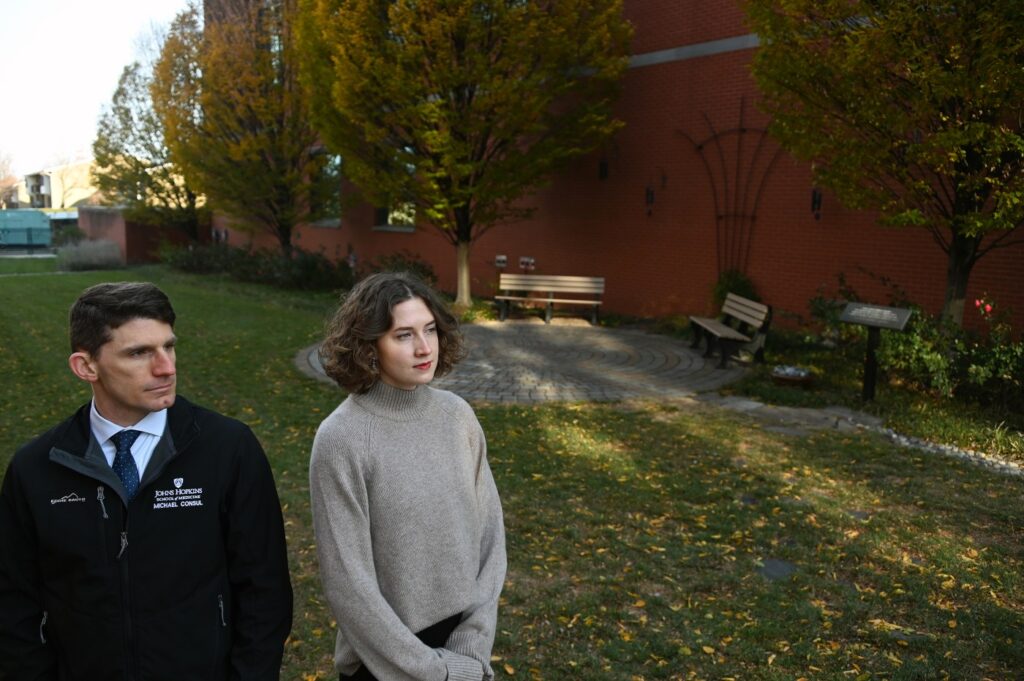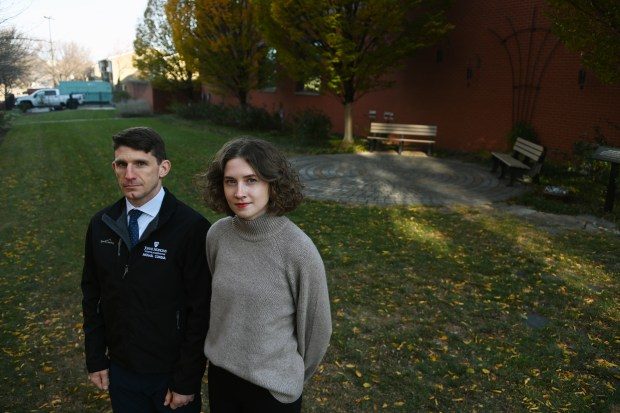‘This is a person’: For Baltimore medical students, dissection triggers deep emotion
- January 4, 2024

Daniela Krahe likely will never know the tall gentleman’s name. He was dead when they met, so she didn’t get the chance to ask.
She’ll never know where the man grew up or whether he had siblings. She won’t know what made him laugh, what movies he liked to watch or what meal his mother used to make him when he was sick.
But there are things Krahe knows about the man that even those who loved him probably will never learn. Earlier this year, she spent hours studying his heart, his brain, his lungs in the most intimate of detail. She knows the branching pattern of his arteries, what the mesh looked like that repaired his hernia.
It’s a strange sort of contradiction, one that thousands of medical students like Krahe experience each year. While technology and virtual reality are used increasingly in medical schools across the country to teach students anatomy and physiology, many — including two based in Baltimore — require future doctors to take a course in which they dissect a human body.
For many students at the Johns Hopkins University School of Medicine and the University of Maryland School of Medicine, the experience means something more than a passing grade. It’s likely that, for the rest of their career, they will remember the person who donated their body to help advance medical research and train future doctors.
Adam Puche does. If he thinks about it, he still can picture the face of the first donor he worked with.
“Nobody ever forgets the generosity of that individual,” said Puche, vice chair of neurobiology at the University of Maryland’s medical school. “I’ve spoken to alumni who graduated from the University of Maryland School of Medicine 50 years ago. They remember where they were standing in the room and who they were working with 50 years ago.”
The number of whole body donations received each year by the Maryland Anatomy Board has more than doubled in the past two decades — from 484 in 2003 to 1,181 in the most recent fiscal year, according to data provided by Chase Cook, a spokesman for the Maryland Department of Health. As of this year, about 2,500 Marylanders had registered with the state anatomy board, indicating that they would like to donate their body to science after they die.
All medical schools in Maryland receive donor bodies from the state anatomy board, as do many biomedical researchers in the state and many hospitals that have resident and surgeon training programs, Cook wrote in an email. In most cases, a donor’s body is returned to the board within a year and a half, according to the board’s website. It is then cremated, and the ashes are returned to the family or interred in a dedicated gravesite in Sykesville.
Each year, the anatomy board and both medical schools hold separate ceremonies where they honor donors.
At the University of Maryland, students work with two donors throughout the first two years of their education. The school recently revamped its curriculum to teach students about anatomy in systems, rather than all at once, Puche said. When they study the cardiovascular system, they dissect a heart — when they learn about neurology, they study a brain.
At Hopkins’ medical school, however, first-year medical students take a seven-week course in which they thoroughly dissect a single donor, following the guidance of a textbook called Grant’s Dissector.
The course begins slowly, said Siobhan Cooke, an associate professor of functional anatomy and evolution. An older medical student introduces the first-year students to their donors. They discuss overall anatomy and make basic observations about the bodies, but they also talk about any emotions they might be experiencing at the prospect of beginning the dissection.
The reactions that students have each year always vary, Cooke said. One or two always cry. Others are more excited than apprehensive. For some, it’s their first up-close experience with death. The average age of a first-year medical student at Hopkins is 24 — they may have lost a grandparent or great-aunt or uncle, but most have yet to reach the stage of life when loss hits closer and comes faster.
Matthew Guo, now a fourth-year student at Hopkins, had just graduated from Cornell University when he started medical school. Shortly before he came to Baltimore, he had lost a family member. Maybe because the loss was so fresh, it was easy for Guo to imagine a life story for his donor — a small elderly woman.
One day, when he was holding her heart in his hands, the grief hit him all at once.
“I was like, ‘If my family member had decided to donate their body, somebody else — some random person on the planet — could have been holding their heart,’” he said. “It was a very unsettling moment.”
He left class early that day.

Krahe — a first-year student at Hopkins — also wasn’t new to death when she started medical school. She previously worked in emergency medicine services and as an artificial heart engineer, both jobs that involved end-of-life care. Still, earlier this year when she was taking Cooke’s course, she found it hard not to think about her donor outside the classroom.
“It’s really hard to not think about them as a person even when you are in the lab,” Krahe said. “And even if there is a split second, where you’re so focused on dissecting something in the lab, immediately when you look at the hands or the fingernails or the face or the feet, you’re brought back to, ‘This is a person.’”
Michael Consul, a second-year medical student at Hopkins, remembers having a less emotional experience in Cooke’s course. On a recent afternoon — after listening to Krahe and Guo talk about their reactions with a Baltimore Sun reporter over Zoom — Consul wondered aloud whether his response was normal. (This year, he was one of the older medical students who assured first-year students in Cooke’s course that all the emotions they would experience throughout their dissection were normal.)
What he does remember, however, is the sense of protection he felt toward his donor, a woman with fiery red nail polish. Throughout the dissection, even as her tissues became disrupted and her human form became less identifiable, he felt compelled to protect her modesty as much as possible.
The simulation technology available at medical schools today is incredible, Consul said. But the experience of working with a donor — of treating someone with respect and dignity even when they’re not watching — isn’t something that can be replicated virtually, he said.
“They certainly do not convey the same sense of, ‘This is a person,’” he said. “‘This is how you take care of them.’”
Most Viewed
More
- AandE
- Allegheny
- Books
- Celebrities
- Celebrity News
- Downtown Pittsburgh
- Editors Picks
- Golf
- Health Now
- Lifestyles
- Local
- MLB
- Monroeville
- More A and E
- More Lifestyles
- Most Recent Obituaries
- Movies TV
- Murrysville
- Music
- News
- News & Advice
- NFL
- NHL
- Northside
- Norwin
- Penn Hills
- Pirates
- Pitt
- Pittsburgh
- Plum
- Politics Election
- Sports
- Steelers
- Theater Arts
- Top Stories
- Travel
- Tribune Review Obituaries
- US-World
- Valley News Dispatch
- West End
- Westmoreland
- World